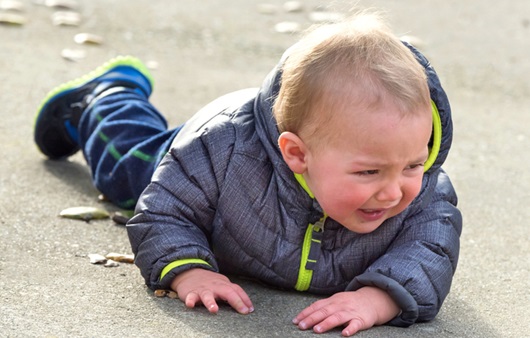Understanding the Risks of Baby Falls: Causes, Precautions, and Prevention Tips
Understanding the Risks of Baby Falls: Causes, Precautions, and Prevention Tips
Introduction
Falls are one of the most common causes of injury among babies and young children. As babies grow and develop, they become more curious and mobile, increasing the risk of accidents. While many falls result in minor injuries, some can lead to serious consequences. In this blog, we’ll explore the common causes of baby falls, real-life incidents, and actionable tips to prevent these accidents and ensure your baby’s safety.
1. Why Are Babies at Risk of Falling?
Babies are particularly vulnerable to falls because:
- Limited Mobility Awareness: They are still developing balance and coordination.
- Curiosity: Babies naturally want to explore their surroundings.
- Physical Development: Rolling, crawling, and walking milestones increase the risk of falls.
- Height Differences: Even short distances, such as falling off a bed or sofa, can result in injuries.
2. Common Causes of Baby Falls
Here are the most frequent scenarios where baby falls occur:
A. Falls from Beds or Sofas
- Why It Happens: Babies may roll unexpectedly or wiggle to the edge.
- Example Incident:
- A 4-month-old rolled off a bed when left unattended for a moment, resulting in a mild head bump.
B. Falls from Changing Tables
- Why It Happens: Caregivers may step away briefly, leaving the baby unsupervised.
- Example Incident:
- A 6-month-old fell from a changing table when the parent turned to grab a diaper, leading to a fractured arm.
C. High Chair or Stroller Falls
- Why It Happens: Babies may wiggle out of their harnesses or tip over the chair.
- Example Incident:
- A 10-month-old leaned forward in a high chair without being properly strapped, causing the chair to tip over.
D. Falls Down Stairs
- Why It Happens: Crawling or walking babies may access unsecured stairs.
- Example Incident:
- A 1-year-old fell down a flight of stairs when a safety gate was left open, resulting in minor bruises.
E. Playground Falls
- Why It Happens: Toddlers may lose balance while climbing or using playground equipment.
- Example Incident:
- A 2-year-old fell from a low slide, sustaining a minor sprain.
3. Potential Injuries from Baby Falls
While many falls result in minor injuries, some can lead to more serious issues:
- Head Injuries:
- Bruises, bumps, or in severe cases, concussions or skull fractures.
- Broken Bones:
- Arms, legs, or collarbones are the most common fractures.
- Cuts and Scrapes:
- Surface injuries that may require stitches.
- Internal Injuries:
- Rare but serious, including internal bleeding or organ damage.
4. Warning Signs to Watch After a Fall
If your baby falls, look for these signs of injury:
- Unusual Behavior: Excessive crying, irritability, or lethargy.
- Vomiting: Could indicate a head injury.
- Bruises or Swelling: Especially on the head or limbs.
- Difficulty Moving: Refusal to use a limb or difficulty sitting/standing.
- Seizures or Loss of Consciousness: Requires immediate medical attention.
When to Call a Doctor:
- Any fall from a height of more than 3 feet.
- Signs of a head injury or loss of consciousness.
- Persistent vomiting or drowsiness.
- Difficulty breathing or severe pain.
5. How to Prevent Baby Falls
Preventing falls requires vigilance and the right safety measures. Here are practical tips to keep your baby safe:
A. Secure Furniture
- Use safety straps on changing tables, high chairs, and strollers.
- Avoid placing your baby on elevated surfaces without supervision.
B. Install Safety Gates
- Place gates at the top and bottom of staircases.
- Ensure gates are securely installed and cannot be pushed over.
C. Never Leave Your Baby Unattended
- Always stay close when your baby is on a bed, sofa, or changing table.
- Use a crib or playpen for unsupervised moments.
D. Create a Safe Play Area
- Use soft mats or carpets in play areas to cushion potential falls.
- Remove sharp-edged furniture or cover corners with padding.
E. Use Proper Restraints
- Always strap your baby securely into high chairs, strollers, and car seats.
- Ensure harnesses are adjusted correctly to prevent wiggling out.
F. Monitor Crawling and Walking Areas
- Keep floors clear of tripping hazards like toys or loose rugs.
- Block access to dangerous areas like stairs, windows, and balconies.
G. Educate Caregivers
- Ensure all caregivers understand your baby’s mobility level and the importance of safety measures.
6. Real-Life Lessons: Stories from Parents
Sharing experiences helps other parents stay vigilant. Here’s a real-life example:
- Case Study: A mother shared how her 8-month-old rolled off the bed despite being placed in the middle. She now always uses a crib for naps, realizing how quickly babies can move unexpectedly.
7. Why Fall Prevention Matters
Preventing falls not only ensures your baby’s safety but also:
- Promotes Healthy Development: Babies can explore their environment safely without fear of injury.
- Reduces Parental Stress: Knowing your home is baby-proofed gives peace of mind.
- Avoids Medical Emergencies: Simple precautions can prevent trips to the emergency room.
8. Conclusion
Falls are a common risk as babies grow and explore their environment. By understanding the causes and taking proactive steps to prevent accidents, you can create a safe and secure space for your baby to thrive. Always stay vigilant, educate caregivers, and trust your instincts when it comes to your child’s safety.
Call to Action
Have you experienced a baby fall or have tips to share? Leave a comment below to help other parents! For more parenting advice and safety tips, follow this blog.






Comments